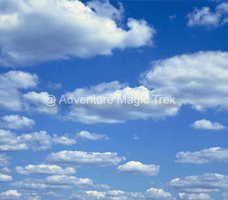
24 Hours Support Call
+977-9841570317 (Shankar Pandey)
email:info@adventurehikenepal.com
Private Kathmandu Day Tour
Sightseeing Tour in Nepal
Departure: Daily
Duration: 4 to 10 Hours
Starts from: Thamel
Ends at: Pashupatinath
Starting Time: 08:00 am
Destinations: Kathmandu Durbar Square, Pashupatinath Temple, Swyambunath
The political, commercial and cultural hub of Nepal is the first stop for the majority of visitors to the country. Once a separate kingdom in itself, it contains three fabled cities - Kathmandu, Patan and Bhaktapur. Out of ten UNESCO World Heritage Sites, seven cultural heritage sites are in Kathmandu Valley.
The history of the Valley begins with the Buddhist saint Manjushree who slashed a passage through the surrounding hills to drain out the primordial waters and make it inhabitable. Over the centuries, a refined urban civilization emerged, built on a unique synthesis of Hinduism and Buddhism.
Kathmandu Durbar Square : 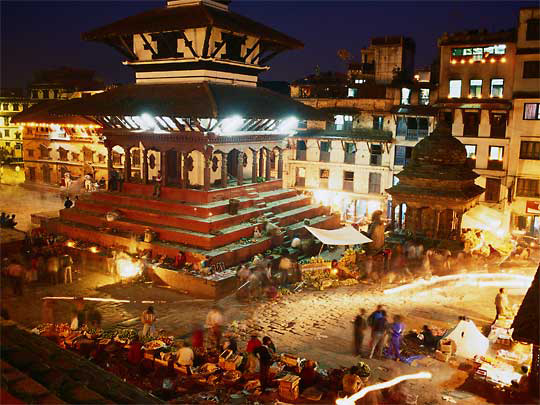
While browse around Katmandu Durbar Square you will visit Hanuman Dhoka, the old and historic palace of Kathmandu named after monkey God, Hanuman. It is historic seat of royalty. The Kings of Nepal are crowned and their coronations also held inside the court yard here. There is a statue of King Pratap Mall sitting on the stone pillar in the front and temple of Jagannath from mediaeval period .Within the walking distance you will find the tall temple of Taleju from 1549 AD, the large stone statue of Kal Bhairav, the God of destruction,. the Big Bell and Big Drum and Hindu Lord Shiva and his consort Parvati peeping from window. Visit the temple of Kumari, the residence of Living Goddess within the vicinity. Kumari means the virgin girl. The girl is selected from Buddhist family. The building has profusely carved wooden balconies and window screen. Next a very interesting temple is Kasthamandap which is believed to be built from a single tree trunk and the name Katmandu is derived from this temple.
 Swayambhunath:
Swayambhunath:
This is a 2500 years old stupa situated on a hillock about 77 m above the ground level and over looking Katmandu valley. The painted eyes on four sides represent the all seeing eyes of Buddha and are watching all the time wrong doers and good doers.This is a very religious shrine of Buddhists. There are two Buddhist monasteries within the complex and a temple of Haratima where both Buddhists and Hindus worship this temple. The shrine is just 3 km to the northwest of Kathmandu city.
Pashupatinath
This is an extremely sacred temple complex (non-Hindus are not allowed inside the main temple) on the banks of the holy Bagmati river. Here, monkeys run up and down the steps of the burning ghats (ie where cremations take place), and trident-bearing saddhus draped in burnt orange and yellow sit serenely meditating, if they aren’t posing for photos.
Boudhanath Stupa
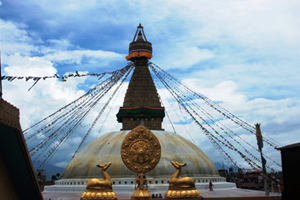 Here the striking Buddha eyes watch over a lively and colorful Tibetan community. Pilgrims from all over the Himalayan Buddhist realm circle the giant stupa morning, noon and evening.
Here the striking Buddha eyes watch over a lively and colorful Tibetan community. Pilgrims from all over the Himalayan Buddhist realm circle the giant stupa morning, noon and evening.
Bauddhanath:
This stupa is 6 km to the east of Kathmandu and is said built in 5th century AD. This ancient stupa is one of the biggest in the world and is ringed by Buddhist lamas and monasteries. This is a very holy stupa for Tibetan Buddhists who come here in thousands in winter festival to pay their tribute.
Guhyeshwari Temple: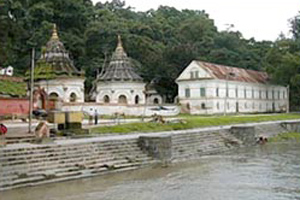
Near Pashupatinath is located another historic and holy temple dedicated to Goddess Guhyeshwari. Only Hindus are allowed to enter the temple courtyard.
Machhendranath Temple:
The temple of Sweta Machhendra Bahal situated between India Chowk and Asan. It is a Pagoda of considerable artistic beauty is also called as "Janmadyo" or "Machhendra" deity.
Patan Durbar Square:
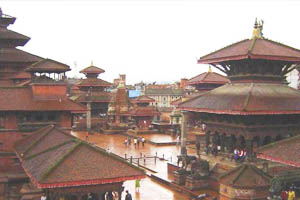 The ancient city Patan is also known as Lalitpur, which means city of fine arts lies 5 km to the south of Katmandu. The whole complex of Durbar Square consists of different sections of ancient palace like Sundari Chowk (beautiful court yard) where exquisite windows and door carving are seen and the Tushahity (Royal Bath) a master piece of stone carvings and others are Mul Chowk (main court yard), Keshav Narayan Chowk. In front of the palace in the main square there is a statue of King Narendra Malla sitting on the stone pillar. Next to the pillar there is a famous Krishna Mandir temple with 21 pinnacles built all in stone. This is said to be a Shikhara architect from India. Rest you will see several pagoda style temples like temple of Bhimsen, and the public bath, dragon headed spout and the water runs 24 hours. There are also many other famous Buddhist temple like Hiranya Verna Maha Vihar (the Golden temple) and Maha Bouddha with ten thousands Buddha's images. Most of the people of Patan city are Buddhists. Patan is also very famous in its art work. There are many fine craftsmen in Patan who produce bronze/brass art work in different images/statues of Hindu/Buddhist Gods and Goddesses, silver jewelleries, wood carvings,. Most of the handicrafts you see in the local shops of Katmandu valley are produced in Patan.
The ancient city Patan is also known as Lalitpur, which means city of fine arts lies 5 km to the south of Katmandu. The whole complex of Durbar Square consists of different sections of ancient palace like Sundari Chowk (beautiful court yard) where exquisite windows and door carving are seen and the Tushahity (Royal Bath) a master piece of stone carvings and others are Mul Chowk (main court yard), Keshav Narayan Chowk. In front of the palace in the main square there is a statue of King Narendra Malla sitting on the stone pillar. Next to the pillar there is a famous Krishna Mandir temple with 21 pinnacles built all in stone. This is said to be a Shikhara architect from India. Rest you will see several pagoda style temples like temple of Bhimsen, and the public bath, dragon headed spout and the water runs 24 hours. There are also many other famous Buddhist temple like Hiranya Verna Maha Vihar (the Golden temple) and Maha Bouddha with ten thousands Buddha's images. Most of the people of Patan city are Buddhists. Patan is also very famous in its art work. There are many fine craftsmen in Patan who produce bronze/brass art work in different images/statues of Hindu/Buddhist Gods and Goddesses, silver jewelleries, wood carvings,. Most of the handicrafts you see in the local shops of Katmandu valley are produced in Patan.
Bhaktapur (Bhadgaon) Durbar Square:
City of devotees lies little aloof from Katmandu and Patan to the east 12 km away. As soon as you enter the gate of Durbar Square of Bhaktapur the whole complex is impressive, wider, clean and beautiful with beautiful Lion Gate,Golden Gate, palace of 55 windows, Batsala temple, barking Bell, the statue of King Bhupatendra Mall on a stone pillar, public bath and temple of Pasupatinath After strolling down to corner lane you come another big square. On the left you will find the tallest temple of Nyatapola which means 5 tiers representing symbols of 5 basic elements of nature such as water,wind,fire, earth and sky. This ia a highest pagoda temple of Nepal ever built with architectural perfection and artistic beauty in 1702 AD by the King Bhupatendra Malla. Next to Nyatapola is another giant temple of Bhairavnath, the God of Terror in three story built in 1718 AD. If you walk ahead for about 20 minutes you will come to another square of a Dattatraya temple built in 1427 AD from a trunk of single tree. Behind the temple there is a monastery where you will notice exquistely carved door frame and windows and also a famous peacock window back wall of the monastery.
Changu Narayan: 
This is the oldest temple of Vishnu built in early 5th century AD situated at the end of long ridge which runs well into the valley. This place is to the northeast 20 km from Katmandu through the countryside. It commands most magnificent views of Katmandu valley and Himalayas ranges on the back ground. This is also a most important historical, religious place where one can see largest number of finest stone sculptures dating back to 5th-9th century AD. This is also known as living monumental garden.
Temple Of Kumari (Kumar Ghar)
The temple or the residence of Living Goddess, "Kumari", is situated in the vicinity of Hanuman Dhoka Palace. The building has profusely carved wooden balconies and window screens. The Kumari - the Living Goddess, acknowledges the greetings from her balcony window. Photography is prohibited here.

Kirtipur:
It lies about 8 km to the south-west of Katmandu on the top of a hill. This is an old Newar village town and people are farmers and living in old traditional culture. The town offers to see many old temples and Buddhist shrines. One can find people weaving in old traditional looms.
Dakshinakali:
It is about 21 km drive through the country to the south of Katmandu. The spectacular views of beautiful landscapes, terraced farmlands and Himalayan ranges on the back ground can be seen while on drive. The road ends right at the temple. Dakshinkali , the supreme Hindu powerful Goddess is worshiped and animals like male-goats and roosters are also sacrificed. This type of rituals take place twice a week Saturday and Tuesday. On our way back visit Shesh Narayan temple dedicated to Lord Vishnu and a Buddhist monastery where you will find the Lama monks chanting the prayers. Also visit of Chovar gorge through where the water of the valley is drained out.
Nagarkot:
 This is 32 km to the north-east of Katmandu and hour drive through the windy road situated at 2175 meter from the sea level, This is magnificent place to view the panorama of major peaks of eastern Himalayan ranges including Mt. Everest on clear days. It is also very spectacular to watch the sunrise and sunset over the Himalayan ranges. There are also number of luxury hotels and lodges available for accommodation to spend the night. Short day hiking can be done to explore the Tamang villages and other areas of interest for easy going trekkers.
This is 32 km to the north-east of Katmandu and hour drive through the windy road situated at 2175 meter from the sea level, This is magnificent place to view the panorama of major peaks of eastern Himalayan ranges including Mt. Everest on clear days. It is also very spectacular to watch the sunrise and sunset over the Himalayan ranges. There are also number of luxury hotels and lodges available for accommodation to spend the night. Short day hiking can be done to explore the Tamang villages and other areas of interest for easy going trekkers.
Dhulikhel:
This is another country drive trip to the east 30 km on the side of the Arniko highway connecting to Tibet border. This is also equally nice place for panoramic viewing of snowy mountain ranges from Karyolung in the east to Himalchuli in the west. From the hilltop you can view colorful landscapes. There are number of luxury hotels and lodges available for spending the night. Day return hiking can be done to explore number of villages during the stay in Dhulikhel.



